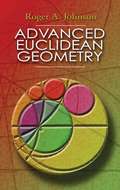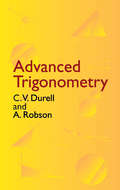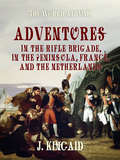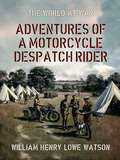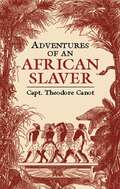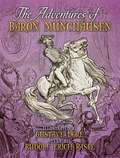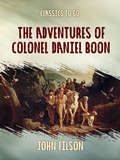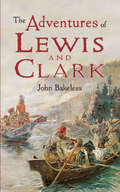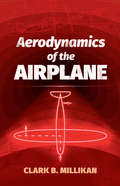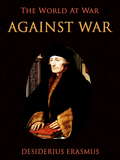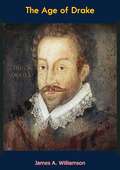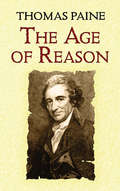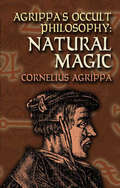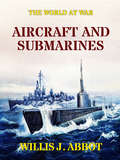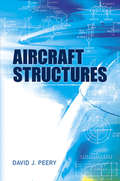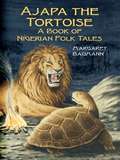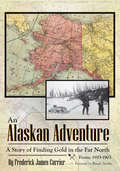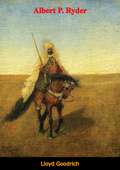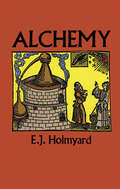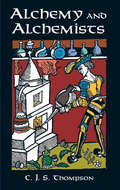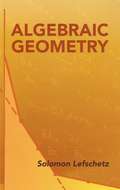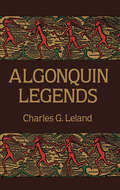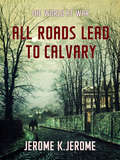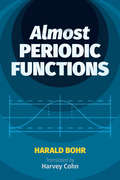- Table View
- List View
Advanced Euclidean Geometry
by Roger A. JohnsonFor many years, this elementary treatise on advanced Euclidean geometry has been the standard textbook in this area of classical mathematics; no other book has covered the subject quite as well. It explores the geometry of the triangle and the circle, concentrating on extensions of Euclidean theory, and examining in detail many relatively recent theorems. Several hundred theorems and corollaries are formulated and proved completely; numerous others remain unproved, to be used by students as exercises.The author makes liberal use of circular inversion, the theory of pole and polar, and many other modern and powerful geometrical tools throughout the book. In particular, the method of "directed angles" offers not only a powerful method of proof but also furnishes the shortest and most elegant form of statement for several common theorems. This accessible text requires no more extensive preparation than high school geometry and trigonometry.
Advanced Trigonometry
by A. Robson C. V. DurellThis volume will provide a welcome resource for teachers seeking an undergraduate text on advanced trigonometry, when few are readily available. Ideal for self-study, this text offers a clear, logical presentation of topics and an extensive selection of problems with answers. Contents include the properties of the triangle and the quadrilateral; equations, sub-multiple angles, and inverse functions; hyperbolic, logarithmic, and exponential functions; and expansions in power-series. Further topics encompass the special hyperbolic functions; projection and finite series; complex numbers; de Moivre's theorem and its applications; one- and many-valued functions of a complex variable; and roots of equations. 1930 edition. 79 figures.
Adventures in the Rifle Brigade, in the Peninsula, France, and the Netherlands (The World At War)
by John KincaidThe memoirs of Capt. J. Kincaid covering his experiences in the famous Rifle Brigade. The Rifle Brigade (Prince Consort's Own) was an infantry rifle regiment of the British Army, formed in 1800 to provide sharpshooters, scouts and skirmishers. They later became part of the Royal Green Jackets. The brigade was distinguished by its use of green uniforms as standard in place of the traditional red, the first regular infantry corps in the British Army to do so.
Adventures of a Motorcycle Despatch Rider (The World At War)
by William Henry Lowe WatsonCaptain William Henry Lowe Watson (1891-1932) was the British author of Adventures of a Despatch Rider (1915). (Excerpt) "This book is not a history, a military treatise, an essay, or a scrap of autobiography. It has no more accuracy or literary merit than letters usually possess. So I hope you will not judge it too harshly. My only object is to try and show as truthfully as I can the part played in this monstrous war by a despatch rider during the months from August 1914 to February 1915. If that object is gained I am content."
Adventures of an African Slaver (African American)
by Captain Theodore CanotGrim account by a former slave ship captain describes the apalling machinery of the commercial slave trade, including the harems and "factories" maintained by slavers, treatment and discipline of black Africans on slave ships, the suppression of slave revolts at sea, and much more. Republication of the classic 1854 edition.
The Adventures of Baron Munchausen
by Rudolf Erich Raspe Gustave DoréA certain eighteenth-century German noble ventured abroad for military service and returned with a series of amusingly outrageous stories. Baron Munchausen's astounding feats included riding cannonballs, traveling to the Moon, and pulling himself out of a bog by his own hair. Listeners delighted in hearing about these unlikely adventures, and in 1785, the stories were collected and published as Baron Munchausen's Narrative of his Marvellous Travels and Campaigns in Russia. By the nineteenth century, the tales had undergone expansions and transformations by several notable authors and had been translated into many languages.A figure as colorful as the Baron naturally appeals to the artistic imagination, and he has been depicted in numerous works of art. His definitive visual image, however, belongs to Gustave Doré. Famed for his engravings of scenes from the Bible, the Divine Comedy, Don Quixote, and other literary classics, Doré created theatrical illustrations of the Baron's escapades that perfectly re-create the stories' picaresque humor.
The Adventures of Colonel Daniel Boon (The World At War)
by John FilsonAn excellent accounting of the adventures of Daniel Boone. Filson was a pioneer beside Boone after the establishment of the settlement at Fort Boonesboro in Kentucky, and though the account was written from the perspective of Boone, it is not stylized and seems to be a very good accounting as if Boone were relating the story directly and merely being written by Filson. (Goodreads)
The Adventures of Lewis and Clark (Dover Children's Classics)
by John BakelessIn 1803, when the United States purchased the Louisiana Territory from France (for a scant $15 million), it doubled the size of the young country. Stretching north from New Orleans to the Canadian border and westward from the Mississippi River to the Rocky Mountains, the area contained over 800,000 square miles. That same year, President Thomas Jefferson designated two young men — Meriweather Lewis and William Clark — as leaders of an expedition to explore this vast new acquisition, as well as other lands of the West. In the spring of 1804, the two men and an intrepid band of hunters, carpenters, gunsmiths, and blacksmiths, known as the "Corps of Discovery," embarked on a perilous journey that would truly give meaning to the term "Wild West." In this exciting, action-packed young reader's edition, based on the author's acclaimed earlier study of the two great American explorers, historian John Bakeless chronicles the daily challenges these men faced — from encounters with indigenous people, snake-infested waterways, prairie fires, floods, heat, and thirst, to illness, famine, and frigid mountain passes. The result is a saga of epic proportions, an amazing story of courage and determination sure to delight readers with its authenticity and vivid, dramatic style.
Aerodynamics of the Airplane (Dover Books on Aeronautical Engineering)
by Clark B. MillikanWritten on the eve of World War II, this brief but intensive introduction by one of the founders of the Jet Propulsion Laboratory deals with the basic problems of aerodynamics. 1941 edition.
Against War (The World At War)
by Desiderius ErasmusA classic anti-war essay from the mid-1500s. Erasmus gives elegant arguments against war from both religious (Christian) and logical (economic, practical) points of view. He seems particularly alarmed and confused by Christians fighting wars with Christians. The problem, of course, is that people waging war only consider religious or logical reasons when they are looking for excuses to wage war.
The Age of Drake
by James WilliamsonTHE STORY OF THE GREATEST AGE IN ENGLISH SEA HISTORY“He was himself the leading authority in our generation on Tudor sea-history, the successor to Sir Julian Corbett in the last. He corrects Corbett’s want of perspective and gives us a proportioned and well-balanced account of the whole story. It is, in fact, much the best book on the greatest age in our sea history…. It is written with that spirit, that freshness and enthusiasm which seem always to go with a love of the sea. On almost every aspect of his subject, Dr. Williamson has something new to say or new information to bring forward. His expert knowledge of navigation and Tudor geography illuminate the book throughout.”—A. L. Rowse, The Spectator
The Age of Reason: Being An Investigation Of True And Fabulous Theology
by Thomas Paine Moncure Daniel Conway"Of all the tyrannies that affect mankind, tyranny in religion is the worst," declared Thomas Paine, adding, "every other species of tyranny is limited to the world we live in; but this attempts to stride beyond the grave, and seeks to pursue us into eternity." Paine's years of study and reflection on the role of religion in society culminated with his final work, The Age of Reason. This coolly reasoned polemic influenced religious thinking throughout the world at the dawn of the nineteenth century, and its resonance remains undiminished by time. The selfsame humanist and egalitarian views that made Paine a popular figure of the American Revolution brought him into frequent conflict with political authorities. Parts of The Age of Reason were written in a French jail, where Paine was confined for his opposition to the execution of Louis XVI. An atack on revealed religion from the deist point of view — embodied by Paine's credo, "I believe in one God, and no more" — this work undertakes a hitherto unheard-of approach to Bible study. Its critical and objective examination of Old and New Testatments cites nemerous contradictions as evidence against literal interpretations of the text. Well articulated and eminently readable, The Age of Reason is a classic of free thought.
Agrippa's Occult Philosophy: Natural Magic (Dover Books On The Occult Ser.)
by Cornelius AgrippaWritten by a legendary scholar of Renaissance esoterica, this is the single most important text in the history of Western occultism, Cornelius Agrippa (1486-1535) combined classical Neoplatonic and Hermetic philosophy with elements of the Jewish Kabbalah and Christianity to form a systematic exposition of occult knowledge. Agrippa's view of divine order was subsequently eclipsed by the materialism and atheism of the Enlightenment, but 500 years later, his influential work endures as a cornerstone of mystic literature.In serious, educated, and accessible terms, Agrippa defines occultism and magic as a natural means of attaining knowledge and power. His explanations of planetary rulerships, enchantments, sorceries, types of divination, and the interpretation of dreams offer an intriguing array of possibilities: improved health, prolonged life, increased wealth, and enhanced foresight. This inexpensive edition of his classic study offers students of the history of ideas and occult traditions an essential reference tool.
Aircraft and Submarines: The Story Of The Invention, Development, And Present-day Uses Of War's Newest Weapons (classic Reprint) (The World At War)
by Willis J. Abbot(Excerpt) "Not since gunpowder was first employed in warfare has so revolutionary a contribution to the science of slaughtering men been made as by the perfection of aircraft and submarines. The former have had their first employment in this world-wide war of the nations. The latter, though in the experimental stage as far back as the American Revolution, have in this bitter contest been for the first time brought to so practical a stage of development as to exert a really appreciable influence on the outcome of the struggle."
Aircraft Structures (Dover Books on Aeronautical Engineering)
by David J. PeeryStill relevant decades after its 1950 publication, this legendary reference text on aircraft stress analysis is considered the best book on the subject. It emphasizes basic structural theory, which remains unchanged with the development of new materials and construction methods, and the application of the elementary principles of mechanics to the analysis of aircraft structures. Suitable for undergraduate students, this volume covers equilibrium of forces, space structures, inertia forces and load factors, shear and bending stresses, and beams with unsymmetrical cross sections. Additional topics include spanwise air-load distribution, external loads on the airplane, joints and fittings, deflections of structures, and special methods of analysis. Topics involving a knowledge of aerodynamics appear in final chapters, allowing students to study the prerequisite aerodynamics topics in concurrent courses.
Ajapa the Tortoise: A Book of Nigerian Folk Tales
by Margaret BaumannLong before people could turn to books for instruction and amusement, they relied upon storytellers for answers to their questions about life. Africa boasts a particularly rich oral tradition, in which the griot -- village historian -- preserved and passed along cultural beliefs and experiences from one generation to the next. This collection of 30 timeless fables comes from the storytellers of Nigeria, whose memorable narratives tell of promises kept and broken, virtue rewarded, and treachery punished.Ajapa the Tortoise -- a trickster, or animal with human qualities -- makes frequent appearances among the colorful cast of talking animals. In "Tortoise Goes Wooing," he learns a valuable lesson in friendship and sharing. Ajapa's further adventures describe how, among other things, he became a chief, acquired all of the world's wisdom, saved the king, tricked the lion, and came to be bald. Recounted in simple but evocative language, these ancient tales continue to enchant readers and listeners of all ages.
An Alaskan Adventure: A Story of Finding Gold in the Far North From: 1893-1903
by Frederick James CurrierAs the descendant of early miners, a grandfather who prospected for gold in the Fairbanks area in 1908 and a father who mined from the 1920s through the early 1940s, my interest and fascination with Frederick Currier's manuscript was easily spiked. Currier's quest for gold from 1893 into the 1900s was an admirable pursuit. His account of prospecting ventures in 1898 on the Chena River near Fairbanks is spellbinding, especially in his use of a sternwheeler and his building of cabins as he prospected toward the headwaters. I have great admiration for the early gold prospectors like Frederick Currier since I have sunk a couple of shafts to bedrock with a windlass and know the effort and determination required. The power of a few nuggets can change a person's direction in life. Currier's, An Alaskan Adventure, is well worth reading—more than once.
Albert P. Ryder (The Great American Artists Series)
by Lloyd GoodrichAlbert Pinkham Ryder, along with Winslow Homer and Thomas Eakins, is recognized as one of the great “ancestors” of American painting, although he was largely unknown in his own time. Twentieth-century taste discovered him and his mystical pictures have had a profound effect on modern abstract art.Lloyd Goodrich is Director of the Whitney Museum of American Art under whose auspices his definitive biography of Thomas Eakins was published in 1933. For many years Mr. Goodrich has been carrying on research in the life and work of Albert P. Ryder, in preparation for a definitive biography. Since Ryder’s work has been widely forged, with the forgeries outnumbering the genuine pictures about eight to one, this study has involved examination of hundreds of paintings, using x-rays and other scientific methods. The present volume, originally published in 1959, has the advantage of these years of thorough study.
An Album of Maya Architecture (Native American)
by Tatiana ProskouriakoffMagnificent guide presents 36 sites from Central America and southern Mexico as they appeared more than a thousand years ago: Temple of the Cross, Palenque; Acropolis and Maya sweat bath, Piedras Negras; Red House and north terrace at Chichén Itzá; more. Each illustration features text of archeological finds and line drawing of remains. 95 illustrations.
Alchemy (Dover Books on Engineering)
by E. J. HolmyardAlchemy is thought to have originated over 2000 years ago in Hellenic Egypt, the result of three converging streams: Greek philosophy, Egyptian technology and the mysticism of Middle Eastern religions. Its heyday was from about 800 A.D. to the middle of the seventeenth century, and its practitioners ranged from kings, popes, and emperors to minor clergy, parish clerks, smiths, dyers, and tinkers. Even such accomplished men as Roger Bacon, Thomas Aquinas, Sir Thomas Browne and Isaac Newton took an interest in alchemical matters.In its search for the "Philosopher's Stone" that would transmute base metals into silver and gold, alchemy took on many philosophical, religious and mystical overtones. These and many other facets of alchemy are explored with enormous insight and erudition in this classic work. E. J. Holmyard, a noted scholar in the field, begins with the alchemists of ancient Greece and China and goes on to discuss alchemical apparatus, Islamic and early Western alchemy; signs, symbols, and secret terms; Paracelsus; English, Scottish and French alchemists; Helvetius, Price, and Semler, and much more.Ranging over two millennia of alchemical history, Mr. Holmyard shows how, like astrology and witchcraft, alchemy was an integral part of the pre-scientific moral order, arousing the cupidity of princes, the blind fear of mobs and the intellectual curiosity of learned men. Eventually, however, with the advent and ascension of the scientific method, the hopes and ideas of the alchemists faded to the status of "pseudo-science." That transformation, as well as alchemy's undeniable role as a precursor of modern chemistry, are brilliantly illuminated in this book. Students of alchemy, chemistry, the history of science, and the occult, plus anyone interested in the origin and evolution of one of mankind's most enduring and influential myths, will want to have a copy of this masterly study.
Alchemy and Alchemists
by C. J. ThompsonAlchemy, whose beginnings — possibly in Egypt, Babylon, India, or China — are ancient and obscure, remained undocumented until about 2500 BC. Although it may have originated with metallurgy, the practice rapidly developed an association with magic, pharmacy, and astrology. In this richly illustrated and amply researched study, a noted expert traces the long history of alchemy, from its murky start to modern times. Hermes Trismegistus and other famous alchemists appear here, along with discussions of the craft's associations with chicanery (as memorably portrayed in Ben Jonson's 1610 comedy, The Alchemist), and its role in the secret society of Rosicrucians. Additional topics include the alchemist's laboratory and equipment, alchemical symbols and secret alphabets, noteworthy manuscripts, the influence of astrology, and more. Although regarded today as a pseudoscience, alchemy gave rise to scientific chemistry. This volume illustrates the ways in which efforts to transmute metals — such as the search for the ever-elusive philosopher's stone — stimulated experimentation with hitherto untried substances, leading to improved knowledge of the materials vital to applied chemistry. Anyone intrigued by the origins and practices of this age-old and still-mysterious discipline, as well as those interested in the history of chemistry, will appreciate this concise, authoritative study.
Algebraic Geometry
by Solomon LefschetzThis text for advanced undergraduate students is both an introduction to algebraic geometry and a bridge between its two parts — the analytical-topological and the algebraic. Because of its extensive use of formal power series (power series without convergency), the treatment will appeal to readers conversant with analysis but less familiar with the formidable techniques of modern algebra. The book opens with an overview of the results required from algebra and proceeds to the fundamental concepts of the general theory of algebraic varieties: general point, dimension, function field, rational transformations, and correspondences. A concentrated chapter on formal power series with applications to algebraic varieties follows. An extensive survey of algebraic curves includes places, linear series, abelian differentials, and algebraic correspondences. The text concludes with an examination of systems of curves on a surface.
Algonquin Legends (Native American Ser.)
by Charles G. LelandThis classic collection contains myths, legends, and folklore of the principal Wabanaki, or northeastern Algonquin Indians, i.e. the Passamaquoddies and Penobscots of Maine and the Micmacs of New Brunswick. Most of this material was gathered directly from Indian narrators by Charles G. Leland (1824-1903), a brilliant and gifted Philadelphia-born journalist, essayist, and folklorist.In compiling the work, Leland noted interesting affinities between the myths of the Northeastern tribes and those of the Eskimos, and striking similarities between the myths of the Algonquins and the Eddas, sagas and popular tales of Scandinavia. For example, may of the stories in this book deal with Glooskap, a divinity with strong resemblances to such Norse gods as Thor and Odin. We learn how Glooskap made man from an ash tree, named the animals, gave gifts to men, went to England and France and made America known to the Europeans, and performed many other curious deeds. Here too are the merry tales of Lox, the Mischief-maker, who bears a strong resemblance to Loki of Scandinavian mythology. Also included are the amazing adventures of Master Rabbit, the Chenoo legends, stories of At-o-sis the serpent, the story of the Three Strong Men, the Weewillmekq', tales of magic, and more.Myths and legends provide unique and authentic sources of knowledge about our deepest instincts and ways of interpreting the world and our place in it. This volume remains one of the most powerful and revealing studies of the Algonquin versions of such myths, a thorough, comprehensive collection that will prove invaluable to any student of American Indian culture or myth, folklore, and religion. General readers will also find these tales highly readable and delightfully entertaining.
All Roads Lead to Calvary (The World At War)
by Jerome K. JeromeThe novel "All Roads Lead to Cavalry" offers an irreverent take on the social forces at play in England in the period leading up to and just following the outbreak of World War I. If you're interested in history but often find yourself bored by historical fiction, this funny, one-of-a-kind novel is for you. (Google)
Almost Periodic Functions (Dover Books on Mathematics)
by Harvey Cohn Harald BohrMathematician Harald Bohr, motivated by questions about which functions could be represented by a Dirichlet series, devised the theory of almost periodic functions during the 1920s. His groundbreaking work influenced many later mathematicians, who extended the theory in new and diverse directions. In this volume, Bohr focuses on an essential aspect of the theory — the functions of a real variable — in full detail and with complete proofs.The treatment, which is based on Bohr's lectures, starts with an introduction that leads to discussions of purely periodic functions and their Fourier series. The heart of the book, his exploration of the theory of almost periodic functions, is supplemented by two appendixes that cover generalizations of almost periodic functions and almost periodic functions of a complete variable.
